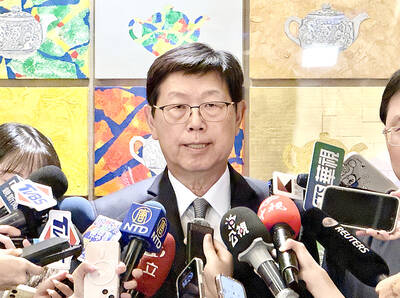AU Optronics Corp (友達光電), the world’s third-largest flat panel maker, yesterday said it would end unpaid leave for engineers and office staff starting next month as it expects demand to recover.
AU Optronics would also stop encouraging some factory workers to take a vacation in light of its rebounding factory utilization rate, Hsiao Ya-wen (蕭雅文), a company spokesperson, said by telephone.
“We have seen utilization rebound at some factories recently and workers may not have to arrange more vacations using annual leave they have accumulated over the years,” Hsiao said.
In January, the Hsinchu-based company requested that office workers and engineers take three days of unpaid leave a month because of weak global demand for electronics.
Last week, AU Optronics chief executive Chen Lai-juh (陳來助) told reporters that factory utilization had improved to around 55 percent this quarter, the top end of an earlier projection of between 50 percent and 55 percent. Chen said rising demand for large liquid-crystal-display (LCD) panels had boosted utilization.
“AU Optronics may see the utilization rate recover to more than 60 percent on average, helped primarily by China’s economic-stimulus packages, including subsidized purchases of PCs and TVs in rural areas,” said Daniel Wang (王德善), who tracks the LCD industry for Primasia Securities Co.
The utilization rate at the company’s sixth-generation plants could be the highest, benefiting from recovering demand for TVs, Wang said.
But he doubted the momentum from China would extend into the next two quarters as demand in the US and Europe remained gloomy.
Wang said an increase in orders might not be sufficient to return Taiwanese LCD makers to profitability because panel prices remained lower than most companies’ manufacturing costs.
Meanwhile, Chi Mei Optoelectronics Corp (奇美電子), the nation’s second-largest LCD panel supplier, yesterday said fewer of its factory workers and engineers were on unpaid leave as the company had seen an increase in rush orders.
But the Tainan-based company did not plan to end the policy any time soon, it said. Chi Mei asked employees to take unpaid leave in November to cope with plummeting demand.

The Taiwan Automation Intelligence and Robot Show, which is to be held from Wednesday to Saturday at the Taipei Nangang Exhibition Center, would showcase the latest in artificial intelligence (AI)-driven robotics and automation technologies, the organizer said yesterday. The event would highlight applications in smart manufacturing, as well as information and communications technology, the Taiwan Automation Intelligence and Robotics Association said. More than 1,000 companies are to display innovations in semiconductors, electromechanics, industrial automation and intelligent manufacturing, it said in a news release. Visitors can explore automated guided vehicles, 3D machine vision systems and AI-powered applications at the show, along

AI SERVER DEMAND: ‘Overall industry demand continues to outpace supply and we are expanding capacity to meet it,’ the company’s chief executive officer said Hon Hai Precision Industry Co (鴻海精密) yesterday reported that net profit last quarter rose 27 percent from the same quarter last year on the back of demand for cloud services and high-performance computing products. Net profit surged to NT$44.36 billion (US$1.48 billion) from NT$35.04 billion a year earlier. On a quarterly basis, net profit grew 5 percent from NT$42.1 billion. Earnings per share expanded to NT$3.19 from NT$2.53 a year earlier and NT$3.03 in the first quarter. However, a sharp appreciation of the New Taiwan dollar since early May has weighed on the company’s performance, Hon Hai chief financial officer David Huang (黃德才)

FORECAST: The greater computing power needed for emerging AI applications has driven higher demand for advanced semiconductors worldwide, TSMC said The government-supported Industrial Technology Research Institute (ITRI) has raised its forecast for this year’s growth in the output value of Taiwan’s semiconductor industry to above 22 percent on strong global demand for artificial intelligence (AI) applications. In its latest IEK Current Quarterly Model report, the institute said the local semiconductor industry would have output of NT$6.5 trillion (US$216.6 billion) this year, up 22.2 percent from a year earlier, an upward revision from a 19.1 percent increase estimate made in May. The strong showing of the local semiconductor industry largely reflected the stronger-than-expected performance of the integrated circuit (IC) manufacturing segment,

COLLABORATION: Softbank would supply manufacturing gear to the factory, and a joint venture would make AI data center equipment, Young Liu said Hon Hai Precision Industry Co (鴻海精密) would operate a US factory owned by Softbank Group Corp, setting up what is in the running to be the first manufacturing site in the Japanese company’s US$500 billion Stargate venture with OpenAI and Oracle Corp. Softbank is acquiring Hon Hai’s electric-vehicle plant in Ohio, but the Taiwanese company would continue to run the complex after turning it into an artificial intelligence (AI) server production plant, Hon Hai chairman Young Liu (劉揚偉) said yesterday. Softbank would supply manufacturing gear to the factory, and a joint venture between the two companies would make AI data